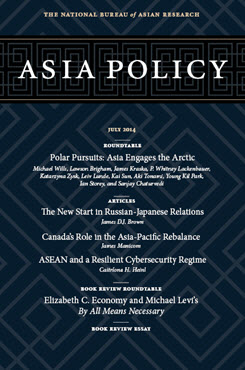Future-Proofing Japan's Interests in the Arctic
Scientific Collaboration and a Search for Balance
This essay is part of the roundtable “Polar Pursuits: Asia Engages the Arctic.”
In May 2013 the Arctic states convened in Kiruna, Sweden, in part to decide on whether six new states should be admitted as observers to the Arctic Council. Japan’s application was accepted along with those of China, India, Italy, Singapore, and South Korea. At a glance, one might ask what credentials Japan has to be involved in the leading Arctic forum. However, a closer look at its engagement in the Arctic indicates that Japan has genuine interests in political, economic, and environmental developments there. This essay examines Japan’s interests in the Arctic, its new role as an observer to the Arctic Council, and the international relationships that will affect Japan’s engagement in the region.
Japan’s Current Engagement in the Arctic
Japan is no newcomer to the Arctic. Already in 1925, the country became one of the fourteen high-contracting parties to the Spitsbergen Treaty, which recognizes the sovereignty of Norway over the Arctic archipelago of Svalbard. In 1990, Japan formally joined the Arctic research community by becoming a member of the International Arctic Science Committee (IASC) as a non-Arctic state. In the same year, the Centre for Arctic Research at the National Institute of Polar Research (NIPR) was established in Japan.
According to the Japanese government, the country’s primary aim of engagement in the Arctic has been and remains understanding and protecting the natural environment. [1] As the negative impacts of climate change became more apparent, policies related to scientific research were given higher priority. Since May 2011, the NIPR has led a nationwide project that seeks to integrate the various strands of Japanese scientific research related to climate change in the Arctic. [2] In addition, since Japan made the decision to prioritize becoming an observer in the Arctic Council, the region has gained a certain level of political momentum and Japan’s Arctic policies have started to gather pace and shape. For instance, just before the council’s decision, an Arctic ambassador was assigned by Japan’s Ministry of Foreign Affairs (MOFA) in March 2013, and the Arctic was included in the central government’s new Basic Plan on Ocean Policy, published in April 2013. [3]
This greater focus on the Arctic can be partly attributed to a stronger lobby from the Ocean Policy Research Foundation (OPRF). OPRF is a think tank and lobbying organization for the Japanese shipping and manufacturing industries and has conducted several research projects on the Arctic, especially regarding the Northern Sea Route (NSR). Guided by the Basic Plan on Ocean Policy, a new interministerial committee on the Arctic (called Hokkyokukai Ni Kakaru Shomondai Ni Taisuru Kankei Shocho Renraku Kaigi, or the Liaison Committee among Ministries and Agencies on Various Issues Related to the Arctic) was set up in July 2013. The Ministry of Land, Infrastructure, Transport and Tourism (MLIT)—one of the more proactive and powerful ministries of Japan—has also shown an interest in the Arctic. In 2013, MLIT conducted a small project to study the practical legal implications of using the NSR along the Russian coast, with a view toward developing the sea route further. More recently, in January 2014, OPRF began collaborating with MLIT and the Ministry of Education, Culture, Sports, Science and Technology (MEXT) on a new project to specifically consider the construction of a new icebreaker for Arctic observations. [4]
Japan’s Reasons for Joining the Arctic Council
Japan’s decision to apply for observer status on the Arctic Council came at a time when the council was beginning to take on new responsibilities. As the Arctic region underwent climate changes, the council’s adoption of new roles related to safety of navigation and search and rescue was taken as an indication that the council itself was changing and that the positions of member states were shifting. [5] The council is the only formal mechanism in the Arctic similar to the Antarctic Treaty System. As a major maritime…
Endnotes
[1] Ministry of Foreign Affairs (Japan), “Hokkyoku: Kanosei to kadai no motarasu mirai” [The Arctic: The Future Arising from the Opportunities and Challenges], December 25, 2013, http://www.mofa.go.jp/mofaj/press/pr/wakaru/topics/vol107.
[2] National Institute of Polar Research, “To the Arctic…Where You Can See the Future of the Earth,” October 2011, http://www.nipr.ac.jp/grene/doc/grene_E.pdf.
[3] Cabinet Office (Japan), “Kaiyo kihon keikaku” [Basic Plan on Ocean Policy], April 2013.
[4] “Hokkyoku kansokusen, seifu ga shinzo kento koro katsuyo, deokure bankai” [The Government Considers Building a New Arctic Observation Ship: Catch Up on Using the Sea Route], Sankei Shimbun, January 26, 2014, http://sankei.jp.msn.com/life/news/140126/trd14012614110012-n1.htm.
[5] Author’s interview with an official at the Ministry of Foreign Affairs, Tokyo, February 17, 2012.
About Asia Policy
Asia Policy is a peer-reviewed scholarly journal presenting policy-relevant academic research on the Asia-Pacific that draws clear and concise conclusions useful to today’s policymakers. Asia Policy is published quarterly in January, April, July, and October and accepts submissions on a rolling basis. Learn more


